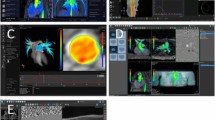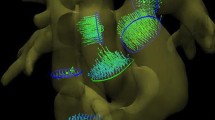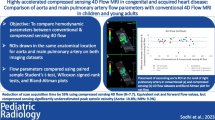Abstract
Background
Cardiovascular flow is commonly assessed with two-dimensional, phase-contrast MRI (2-D PC-MRI). However, scan prescription and acquisition over multiple planes is lengthy, often requires direct physician oversight and has inconsistent results. Time-resolved volumetric PC-MRI (4-D flow) may address these limitations.
Objective
We assess the degree of agreement and internal consistency between 2-D and 4-D flow quantification in our clinical population.
Materials and methods
Software enabling flow calculation from 4-D flow was developed in Java. With IRB approval and HIPAA compliance, 18 consecutive patients without shunts were identified who underwent both (1) conventional 2-D PC-MRI of the aorta and main pulmonary artery and (2) 4-D flow imaging. Aortic and pulmonary flow rates were assessed with both techniques.
Results
Both methods showed general agreement in flow rates (ρ: 0.87–0.90). Systemic and pulmonary arterial flow rates were well-correlated (ρ: 4-D 0.98–0.99, 2-D 0.93), but more closely matched with 4-D (P < 0.05, Brown-Forsythe). Pulmonary flow rates were lower than systemic rates for 2-D (P < 0.05, two-sample t-test). In a sub-analysis of patients without pulmonary or aortic regurgitation, 2-D showed improved correlation of flow rates while 4-D phase-contrast remained tightly correlated (ρ: 4-D 0.99–1.00, 2-D 0.99).
Conclusion
4-D PC-MRI demonstrates greater consistency than conventional 2-D PC-MRI for flow quantification.




Similar content being viewed by others
References
Szolar DH, Sakuma H, Higgins CB (1996) Cardiovascular applications of magnetic resonance flow and velocity measurements. J Magn Reson Imaging 6:78–89
Higgins CB, Sakuma H (1996) Heart disease: functional evaluation with MR imaging. Radiology 199:307–315
Pelc NJ, Herfkens RJ, Shimakawa A et al (1991) Phase contrast cine magnetic resonance imaging. Magn Reson Q 7:229–254
Lew CD, Alley MT, Bammer R et al (2007) Peak velocity and flow quantification validation for sensitivity-encoded phase-contrast MR imaging. Acad Radiol 14:258–269
Korperich H, Gieseke J, Barth P et al (2004) Flow volume and shunt quantification in pediatric congenital heart disease by real-time magnetic resonance velocity mapping: a validation study. Circulation 109:1987–1993
Gatehouse PD, Rolf MP, Graves MJ et al (2010) Flow measurement by cardiovascular magnetic resonance: a multi-centre multi-vendor study of background phase offset errors that can compromise the accuracy of derived regurgitant or shunt flow measurements. J Cardiovasc Magn Reson 12: 5
Pelc NJ, Bernstein MA, Shimakawa A et al (1991) Encoding strategies for three-direction phase-contrast MR imaging of flow. J Magn Reson Imaging 1:405–413
Alley MT, Napel S, Amano Y et al (1999) Fast 3D cardiac cine MR imaging. J Magn Reson Imaging 9:751–755
Markl M, Draney MT, Hope MD et al (2004) Time-resolved 3-dimensional velocity mapping in the thoracic aorta: visualization of 3-directional blood flow patterns in healthy volunteers and patients. J Comput Assist Tomogr 28:459–468
Hope TA, Markl M, Wigström L et al (2007) Comparison of flow patterns in ascending aortic aneurysms and volunteers using four-dimensional magnetic resonance velocity mapping. J Magn Reson Imaging 26:1471–1479
Isoda H, Ohkura Y, Kosugi T et al (2009) In vivo hemodynamic analysis of intracranial aneurysms obtained by magnetic resonance fluid dynamics (MRFD) based on time-resolved three-dimensional phase-contrast MRI. Neuroradiology 52:921–928
Hope MD, Hope TA, Meadows AK et al (2010) Bicuspid aortic valve: four-dimensional MR evaluation of ascending aortic systolic flow patterns. Radiology 255:53–61
Peng HH, Bauer S, Huang TY et al (2010) Optimized parallel imaging for dynamic PC-MRI with multidirectional velocity encoding. Magn Reson Med 64:472–480
Brix L, Ringgaard S, Rasmusson A et al (2009) Three dimensional three component whole heart cardiovascular magnetic resonance velocity mapping: comparison of flow measurements from 3D and 2D acquisitions. J Cardiovasc Magn Reson 11:3
Markl M, Chan FP, Alley MT et al (2003) Time-resolved three-dimensional phase-contrast MRI. J Magn Reson Imaging 17:499–506
Roes SD, Hammer S, van der Geest RJ et al (2009) Flow assessment through four heart valves simultaneously using 3-dimensional 3-directional velocity-encoded magnetic resonance imaging with retrospective valve tracking in healthy volunteers and patients with valvular regurgitation. Invest Radiol 44:669–675
van der Hulst AE, Westenberg JJ, Kroft LJ et al (2010) Tetralogy of fallot: 3D velocity-encoded MR imaging for evaluation of right ventricular valve flow and diastolic function in patients after correction. Radiology 256:724–734
Bammer R, Hope TA, Aksoy M et al (2007) Time-resolved 3D quantitative flow MRI of the major intracranial vessels: initial experience and comparative evaluation at 1.5 T and 3.0 T in combination with parallel imaging. Magn Reson Med 57:127–140
Bernstein MA, Zhou XJ, Polzin JA et al (1998) Concomitant gradient terms in phase contrast MR: analysis and correction. Magn Reson Med 39:300–308
Markl M, Bammer R, Alley MT et al (2003) Generalized reconstruction of phase contrast MRI: analysis and correction of the effect of gradient field distortions. Magn Reson Med 50:791–801
Walker PG, Cranney GB, Scheidegger MB et al (1993) Semiautomated method for noise reduction and background phase error correction in MR phase velocity data. J Magn Reson Imaging 3:521–530
O'Brien KR, Myerson SG, Cowan BR et al (2009) Phase contrast ultrashort TE: a more reliable technique for measurement of high-velocity turbulent stenotic jets. Magn Reson Med 62:626–636
Unterhinninghofen R, Ley S, Ley-Zaporozhan J et al (2008) Concepts for visualization of multidirectional phase-contrast MRI of the heart and large thoracic vessels. Acad Radiol 15:361–369
Sørensen TS, Beerbaum P, Körperich H et al (2005) Three-dimensional, isotropic MRI: a unified approach to quantification and visualization in congenital heart disease. Int J Cardiovasc Imaging 21:283–292
Kilner PJ, Gatehouse PD, Firmin DN (2007) Flow measurement by magnetic resonance: a unique asset worth optimising. J Cardiovasc Magn Reson 9:723–728
Acknowledgement
The authors are grateful for the essential support of the Tashia and John Morgridge Foundation.
Author information
Authors and Affiliations
Corresponding author
Rights and permissions
About this article
Cite this article
Hsiao, A., Alley, M.T., Massaband, P. et al. Improved cardiovascular flow quantification with time-resolved volumetric phase-contrast MRI. Pediatr Radiol 41, 711–720 (2011). https://doi.org/10.1007/s00247-010-1932-z
Received:
Revised:
Accepted:
Published:
Issue Date:
DOI: https://doi.org/10.1007/s00247-010-1932-z




